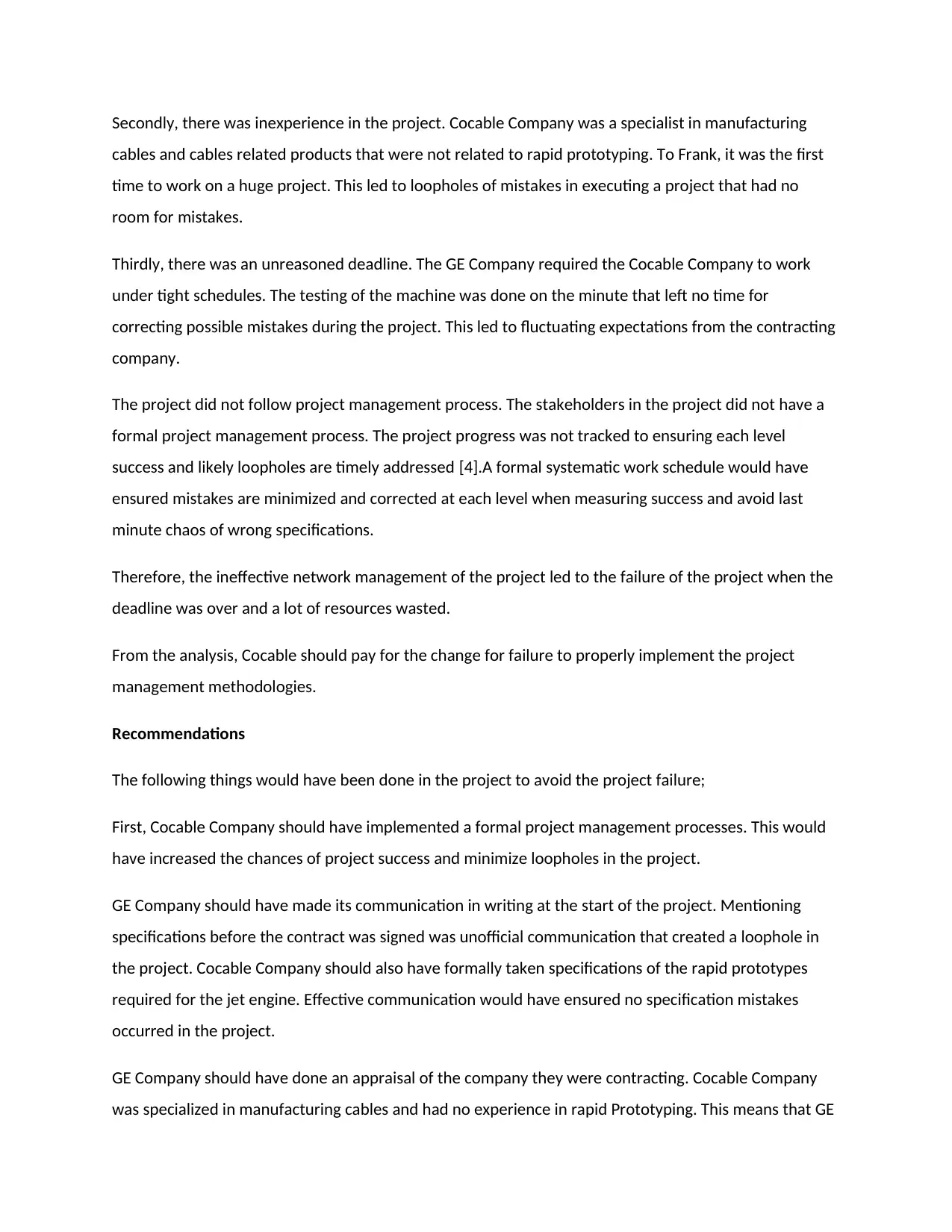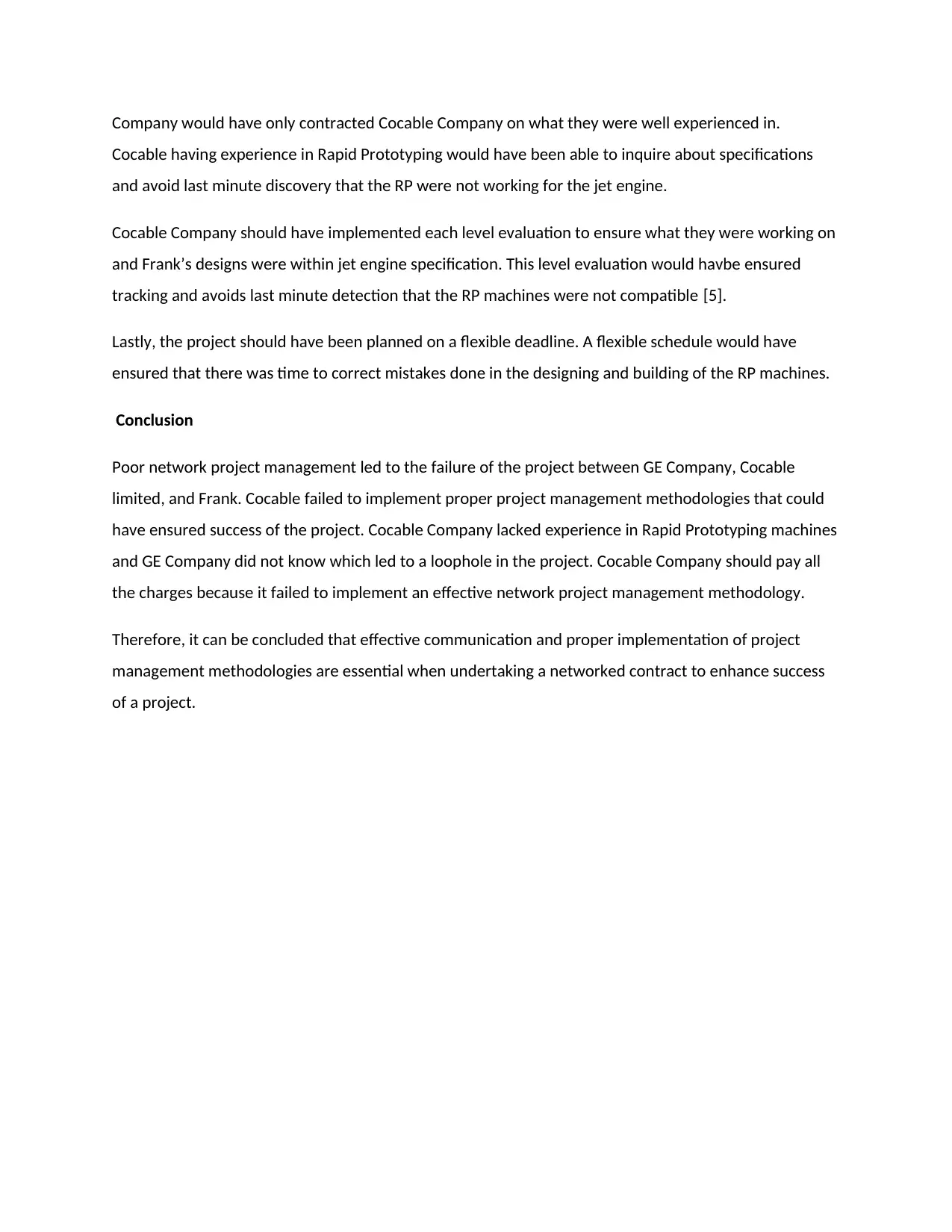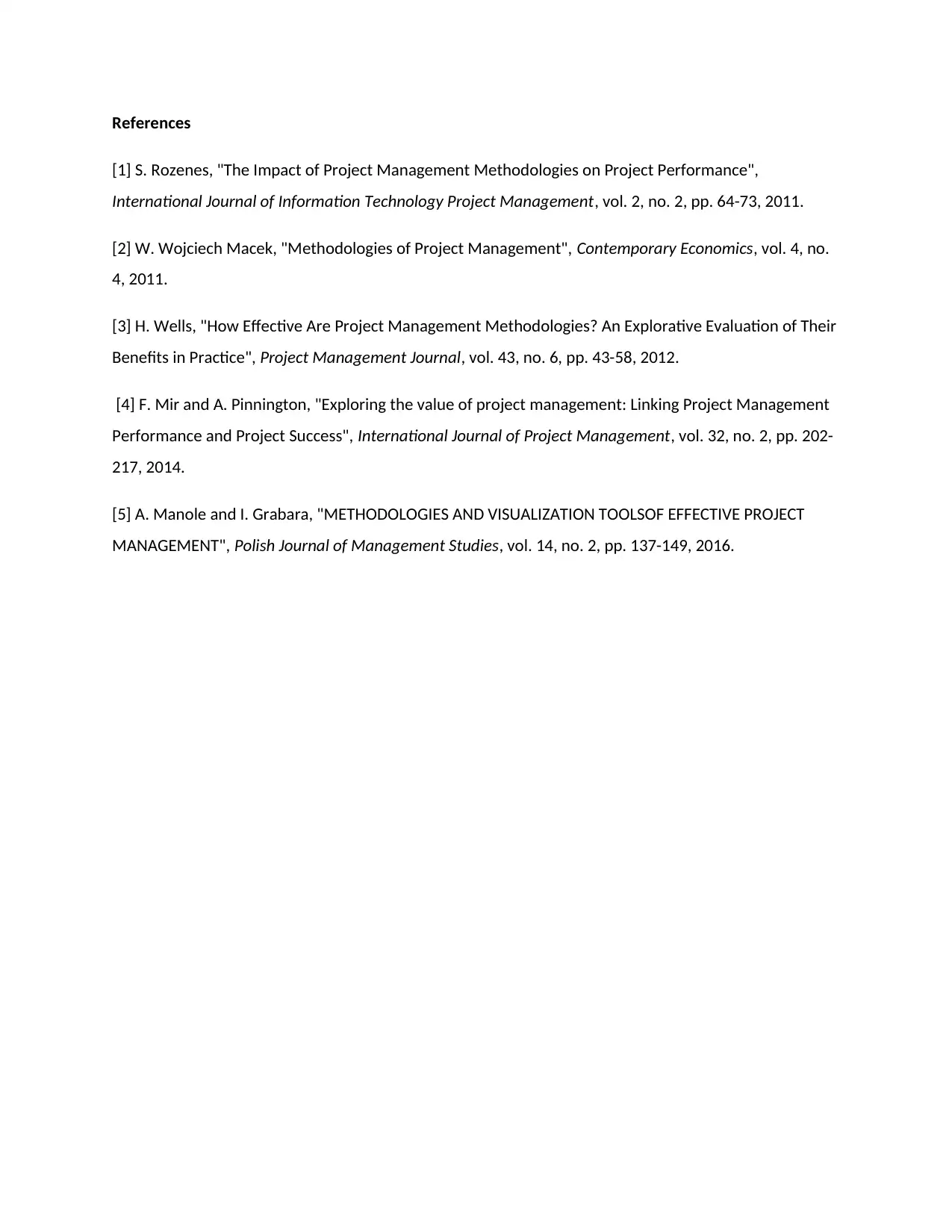Project Management Problems and Recommendations: Case Study Report
VerifiedAdded on 2020/02/24
|5
|1213
|52
Report
AI Summary
This report analyzes a project management failure involving Frank, Cocable Company, and GE Company. The project aimed to design and build rapid prototyping machines for jet engine components. The report identifies key project management problems, including poor communication, inexperience, and an unreasonable deadline. The failure stemmed from the mismatch between the RP machine specifications and the jet engine requirements, which led to the project's failure. The report recommends that Cocable implement formal project management processes, improve communication, and conduct thorough evaluations. It emphasizes the importance of effective communication and the proper application of project management methodologies to ensure project success. The report concludes that Cocable should bear the responsibility for the project's failure due to its ineffective project management practices. The analysis underscores the need for meticulous planning, clear communication, and stakeholder coordination in engineering projects.

UNIT:
NAME:
DATE:
NAME:
DATE:
Paraphrase This Document
Need a fresh take? Get an instant paraphrase of this document with our AI Paraphraser

Executive summary
Project management methodologies are models that are applied in planning, designing, and
implementing a project to achieve predetermined project objectives [1]. Project management problems
occur when project methodologies are not successfully implemented across the process of project
management. Engineering projects require coordination from all stakeholders to ensure that they work
as a team to meet specific goals. Project management requires effective networking to ensure alignment
of the specifications of the product being manufactured [2]. The following report analyses project
management problems and their possible causes a case study of Frank designing and building Rapid
Prototype machines for jet engine job for Cocable Company that was contracted by GE Company. The
report will also outline recommendations on how to avoid project management problems.
Background information
Frank Billing, a passionate entrepreneur in rapid prototyping was contracted to a project together with
Cocable Company to deliver on rapid prototyping machine. The project involved Cocable Company
designing and manufacturing cable installations for GE company newest jet engine. As part of the
project, Cocable was required to design junction boxes and switch covers that required complex shapes
and multiple designs. Frank, haven worked with Cocable for three years before resigning, presented
himself for the job. Frank was contracted to custom build four rapid prototyping machines and their
specifications. Frank designed and built RP machines of 48inchs that could also fit 55inch capacity.
During the testing day, the RP machines did not work because the specifications required were 62inchs.
This led to the project failing and a blame smarted between the three parties.
Project management problems
The following project management problems occurred in designing and building of the Rapid Prototypes
for GE jet engine;
First, there was poor communication: The communication between the GE Company, Cocable Company
and Frank was poor when initiating, designing and implementing the project. There was poor
communication of specifications that lead to production of RP machines that did not meet the jet engine
specifications. The GE Company says it mentioned before the start contracting the Cocable Company
about the RP machine specifications. Frank worked on the wrong specifications as he followed what he
was told by Cocable Company.
Project management methodologies are models that are applied in planning, designing, and
implementing a project to achieve predetermined project objectives [1]. Project management problems
occur when project methodologies are not successfully implemented across the process of project
management. Engineering projects require coordination from all stakeholders to ensure that they work
as a team to meet specific goals. Project management requires effective networking to ensure alignment
of the specifications of the product being manufactured [2]. The following report analyses project
management problems and their possible causes a case study of Frank designing and building Rapid
Prototype machines for jet engine job for Cocable Company that was contracted by GE Company. The
report will also outline recommendations on how to avoid project management problems.
Background information
Frank Billing, a passionate entrepreneur in rapid prototyping was contracted to a project together with
Cocable Company to deliver on rapid prototyping machine. The project involved Cocable Company
designing and manufacturing cable installations for GE company newest jet engine. As part of the
project, Cocable was required to design junction boxes and switch covers that required complex shapes
and multiple designs. Frank, haven worked with Cocable for three years before resigning, presented
himself for the job. Frank was contracted to custom build four rapid prototyping machines and their
specifications. Frank designed and built RP machines of 48inchs that could also fit 55inch capacity.
During the testing day, the RP machines did not work because the specifications required were 62inchs.
This led to the project failing and a blame smarted between the three parties.
Project management problems
The following project management problems occurred in designing and building of the Rapid Prototypes
for GE jet engine;
First, there was poor communication: The communication between the GE Company, Cocable Company
and Frank was poor when initiating, designing and implementing the project. There was poor
communication of specifications that lead to production of RP machines that did not meet the jet engine
specifications. The GE Company says it mentioned before the start contracting the Cocable Company
about the RP machine specifications. Frank worked on the wrong specifications as he followed what he
was told by Cocable Company.

Secondly, there was inexperience in the project. Cocable Company was a specialist in manufacturing
cables and cables related products that were not related to rapid prototyping. To Frank, it was the first
time to work on a huge project. This led to loopholes of mistakes in executing a project that had no
room for mistakes.
Thirdly, there was an unreasoned deadline. The GE Company required the Cocable Company to work
under tight schedules. The testing of the machine was done on the minute that left no time for
correcting possible mistakes during the project. This led to fluctuating expectations from the contracting
company.
The project did not follow project management process. The stakeholders in the project did not have a
formal project management process. The project progress was not tracked to ensuring each level
success and likely loopholes are timely addressed [4].A formal systematic work schedule would have
ensured mistakes are minimized and corrected at each level when measuring success and avoid last
minute chaos of wrong specifications.
Therefore, the ineffective network management of the project led to the failure of the project when the
deadline was over and a lot of resources wasted.
From the analysis, Cocable should pay for the change for failure to properly implement the project
management methodologies.
Recommendations
The following things would have been done in the project to avoid the project failure;
First, Cocable Company should have implemented a formal project management processes. This would
have increased the chances of project success and minimize loopholes in the project.
GE Company should have made its communication in writing at the start of the project. Mentioning
specifications before the contract was signed was unofficial communication that created a loophole in
the project. Cocable Company should also have formally taken specifications of the rapid prototypes
required for the jet engine. Effective communication would have ensured no specification mistakes
occurred in the project.
GE Company should have done an appraisal of the company they were contracting. Cocable Company
was specialized in manufacturing cables and had no experience in rapid Prototyping. This means that GE
cables and cables related products that were not related to rapid prototyping. To Frank, it was the first
time to work on a huge project. This led to loopholes of mistakes in executing a project that had no
room for mistakes.
Thirdly, there was an unreasoned deadline. The GE Company required the Cocable Company to work
under tight schedules. The testing of the machine was done on the minute that left no time for
correcting possible mistakes during the project. This led to fluctuating expectations from the contracting
company.
The project did not follow project management process. The stakeholders in the project did not have a
formal project management process. The project progress was not tracked to ensuring each level
success and likely loopholes are timely addressed [4].A formal systematic work schedule would have
ensured mistakes are minimized and corrected at each level when measuring success and avoid last
minute chaos of wrong specifications.
Therefore, the ineffective network management of the project led to the failure of the project when the
deadline was over and a lot of resources wasted.
From the analysis, Cocable should pay for the change for failure to properly implement the project
management methodologies.
Recommendations
The following things would have been done in the project to avoid the project failure;
First, Cocable Company should have implemented a formal project management processes. This would
have increased the chances of project success and minimize loopholes in the project.
GE Company should have made its communication in writing at the start of the project. Mentioning
specifications before the contract was signed was unofficial communication that created a loophole in
the project. Cocable Company should also have formally taken specifications of the rapid prototypes
required for the jet engine. Effective communication would have ensured no specification mistakes
occurred in the project.
GE Company should have done an appraisal of the company they were contracting. Cocable Company
was specialized in manufacturing cables and had no experience in rapid Prototyping. This means that GE
⊘ This is a preview!⊘
Do you want full access?
Subscribe today to unlock all pages.

Trusted by 1+ million students worldwide

Company would have only contracted Cocable Company on what they were well experienced in.
Cocable having experience in Rapid Prototyping would have been able to inquire about specifications
and avoid last minute discovery that the RP were not working for the jet engine.
Cocable Company should have implemented each level evaluation to ensure what they were working on
and Frank’s designs were within jet engine specification. This level evaluation would havbe ensured
tracking and avoids last minute detection that the RP machines were not compatible [5].
Lastly, the project should have been planned on a flexible deadline. A flexible schedule would have
ensured that there was time to correct mistakes done in the designing and building of the RP machines.
Conclusion
Poor network project management led to the failure of the project between GE Company, Cocable
limited, and Frank. Cocable failed to implement proper project management methodologies that could
have ensured success of the project. Cocable Company lacked experience in Rapid Prototyping machines
and GE Company did not know which led to a loophole in the project. Cocable Company should pay all
the charges because it failed to implement an effective network project management methodology.
Therefore, it can be concluded that effective communication and proper implementation of project
management methodologies are essential when undertaking a networked contract to enhance success
of a project.
Cocable having experience in Rapid Prototyping would have been able to inquire about specifications
and avoid last minute discovery that the RP were not working for the jet engine.
Cocable Company should have implemented each level evaluation to ensure what they were working on
and Frank’s designs were within jet engine specification. This level evaluation would havbe ensured
tracking and avoids last minute detection that the RP machines were not compatible [5].
Lastly, the project should have been planned on a flexible deadline. A flexible schedule would have
ensured that there was time to correct mistakes done in the designing and building of the RP machines.
Conclusion
Poor network project management led to the failure of the project between GE Company, Cocable
limited, and Frank. Cocable failed to implement proper project management methodologies that could
have ensured success of the project. Cocable Company lacked experience in Rapid Prototyping machines
and GE Company did not know which led to a loophole in the project. Cocable Company should pay all
the charges because it failed to implement an effective network project management methodology.
Therefore, it can be concluded that effective communication and proper implementation of project
management methodologies are essential when undertaking a networked contract to enhance success
of a project.
Paraphrase This Document
Need a fresh take? Get an instant paraphrase of this document with our AI Paraphraser

References
[1] S. Rozenes, "The Impact of Project Management Methodologies on Project Performance",
International Journal of Information Technology Project Management, vol. 2, no. 2, pp. 64-73, 2011.
[2] W. Wojciech Macek, "Methodologies of Project Management", Contemporary Economics, vol. 4, no.
4, 2011.
[3] H. Wells, "How Effective Are Project Management Methodologies? An Explorative Evaluation of Their
Benefits in Practice", Project Management Journal, vol. 43, no. 6, pp. 43-58, 2012.
[4] F. Mir and A. Pinnington, "Exploring the value of project management: Linking Project Management
Performance and Project Success", International Journal of Project Management, vol. 32, no. 2, pp. 202-
217, 2014.
[5] A. Manole and I. Grabara, "METHODOLOGIES AND VISUALIZATION TOOLSOF EFFECTIVE PROJECT
MANAGEMENT", Polish Journal of Management Studies, vol. 14, no. 2, pp. 137-149, 2016.
[1] S. Rozenes, "The Impact of Project Management Methodologies on Project Performance",
International Journal of Information Technology Project Management, vol. 2, no. 2, pp. 64-73, 2011.
[2] W. Wojciech Macek, "Methodologies of Project Management", Contemporary Economics, vol. 4, no.
4, 2011.
[3] H. Wells, "How Effective Are Project Management Methodologies? An Explorative Evaluation of Their
Benefits in Practice", Project Management Journal, vol. 43, no. 6, pp. 43-58, 2012.
[4] F. Mir and A. Pinnington, "Exploring the value of project management: Linking Project Management
Performance and Project Success", International Journal of Project Management, vol. 32, no. 2, pp. 202-
217, 2014.
[5] A. Manole and I. Grabara, "METHODOLOGIES AND VISUALIZATION TOOLSOF EFFECTIVE PROJECT
MANAGEMENT", Polish Journal of Management Studies, vol. 14, no. 2, pp. 137-149, 2016.
1 out of 5
Related Documents
Your All-in-One AI-Powered Toolkit for Academic Success.
+13062052269
info@desklib.com
Available 24*7 on WhatsApp / Email
![[object Object]](/_next/static/media/star-bottom.7253800d.svg)
Unlock your academic potential
Copyright © 2020–2025 A2Z Services. All Rights Reserved. Developed and managed by ZUCOL.





